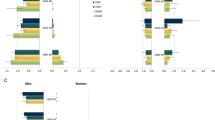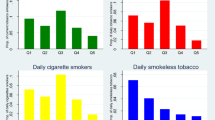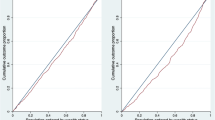Abstract
Objective
To produce internationally comparable estimates of socioeconomic differences in tobacco exposure within low and middle-income countries.
Methods
We used data from 50 countries that participated in the World Health Surveys in 2002–2003. We measured two aspects of smoking: current smoking prevalence and accumulated pack-years of smoking. We used an asset-based approach to estimate permanent income. We measured absolute inequalities, separately by gender, across the entire socioeconomic distribution by using the concentration index and summarized the results and explored heterogeneity by meta-analysis.
Results
The overall prevalence of current smoking was highest in Southeast Asia, the Western Pacific, and Europe, and lowest in Africa. Pack-years among current male smokers were highest in Europe. Wealthier men were generally less likely to be current smokers in all regions. However, there was substantial heterogeneity within each region, and in some countries (Georgia, Mexico, Mauritania) current smoking was greater among the more advantaged. Among currently smoking men socioeconomic differences for pack-years of smoking were generally much weaker than for smoking prevalence. Among women the concentration index in current smoking was largest and favored the poor in Europe (1.4, 95% CI 0.8, 2.1) but favored the rich in Southeast Asia and the Western Pacific. National income was generally not associated with the magnitude of socioeconomic gradients.
Conclusions
In low and middle-income countries there is substantial between and within-region heterogeneity in socioeconomic inequality in tobacco exposure that is not explained by national income. Our results imply that the relationship between socioeconomic position and smoking in poorer countries is dynamic and may not reflect the historical pattern in wealthier countries.




Similar content being viewed by others
References
World Health Organization (2009) Global health risks: mortality and burden of disease attributable to selected major risks. World Health Organization, Geneva
Jha P (2009) Avoidable global cancer deaths and total deaths from smoking. Nat Rev Cancer 9:655–664
John RM, John RM (2005) Tobacco consumption patterns and its health implications in India. Health Policy 71:213–222
Yu Z, Nissinen A, Vartiainen E, Song G, Guo Z, Tian H (2000) Changes in cardiovascular risk factors in different socioeconomic groups: seven year trends in a Chinese urban population. J Epidemiol Community Health 54:692–696
Critchley J, Liu J, Zhao D, Wei W, Capewell S (2004) Explaining the increase in coronary heart disease mortality in Beijing between 1984 and 1999. Circulation 110:1236–1244
Peto R, Boreham J, Lopez AD, Thun M, Heath C (1992) Mortality from tobacco in developed countries: indirect estimation from national vital statistics. Lancet 339:1268–1278
Ezzati M, Lopez AD (2003) Estimates of global mortality attributable to smoking in 2000. Lancet 362:847–852
Wipfli H, Samet JM (2009) Global economic and health benefits of tobacco control: part 1. Clin Pharmacol Ther 86:263–271
Wipfli H, Samet JM (2009) Global economic and health benefits of tobacco control: part 2. Clin Pharmacol Ther 86:272–280
Mackenbach JP, Stirbu I, Roskam AJ et al (2008) Socioeconomic inequalities in health in 22 European countries. N Engl J Med 358:2468–2481
Huisman M, Kunst AE, Mackenbach JP (2005) Inequalities in the prevalence of smoking in the European Union: comparing education and income. Prev Med 40:756–764
Cavelaars AE, Kunst AE, Geurts JJ et al (2000) Educational differences in smoking: international comparison. BMJ 320:1102–1107
Bobak M, Jha P, Nguyen S, Jarvis M (2000) Poverty and smoking. In: Jha P, Chaloupka F (eds) Tobacco control in developing countries. Oxford University Press, New York, pp 41–61
Townsend L, Flisher AJ, Gilreath T et al (2006) A systematic literature review of tobacco use among adults 15 years and older in sub-Saharan Africa. Drug Alcohol Depend 84:14–27
World Health Organization (2008) WHO report on the global tobacco epidemic, 2008. The MPOWER package. World Health Organization, Geneva
Ustun B, Chatterji S, Mechbal A, Murray CJ, groups Wc (2003) The world health surveys. In: Murray CJL, Evans DB (eds) Health systems performance assessment: debates, methods and empiricism. World Health Organization, Geneva, pp 797–808
World Health Organization (2008) World Health Survey instruments and related documents. http://www.who.int/healthinfo/survey/instruments/en/index.html. Accessed 15 July 2011
U.S. Public Health Service, Office of the Surgeon General, National Center for Chronic Disease Prevention and Health Promotion (2004) The health consequences of smoking: a report of the Surgeon General. U.S. Dept. of Health & Human Services, Washington
Ferguson BD, Tandon A, Gakidou E, Murray CJ (2003) Estimating permanent income using indicator variables. In: Murray CJL, Evans DB (eds) Health systems performance assessment: debates, methods and empiricism. World Health Organization, Geneva, p 927
Filmer D, Pritchett LH (2001) Estimating wealth effects without expenditure data—or tears: an application to educational enrollments in states of India. Demography 38:115–132
Ferguson BD, Tandon A, Gakidou E, Murray CJL, Evans DB (2003) Estimating permanent income using indicator variables. Health systems performance assessment: debates, methods and empiricism. World Health Organization, Geneva, pp 747–760
Pampel FC (2006) Global patterns and determinants of sex differences in smoking. Int J Comp Sociol 47:466–487
Royston P (2005) Multiple imputation of missing values: update of ice. Stata J 5:527–536
Stata (2009) Stata multiple-imputation reference manual. Stata Press, Texas
Sen AK, Foster JE (1997) On economic inequality. Clarendon Press, Oxford
Harper S, King NB, Meersman SC, Reichman ME, Breen N, Lynch J (2010) Implicit value judgements in the measurement of health inequalities. Milbank Q 88:4–29
Kakwani N, Wagstaff A, van Doorslaer E (1997) Socioeconomic inequalities in health: measurement, computation, and statistical inference. J Econom 77:87–103
Wagstaff A (2002) Inequality aversion, health inequalities and health achievement. J Health Econ 21:627–641
Sterne JAC (2009) Meta-analysis in Stata: an updated collection from the Stata journal, 1st edn. Strata Press, College Station
DerSimonian R, Laird N (1986) Meta-analysis in clinical trials. Control Clin Trials 7:177–188
Higgins JP, Thompson SG (2002) Quantifying heterogeneity in a meta-analysis. Stat Med 21:1539–1558
The World Bank (2011) World Development indicators. The World Bank. http://data.worldbank.org/data-catalog/world-development-indicators. Accessed 23 Nov 2010
Higgins JP, Thompson SG, Deeks JJ, Altman DG (2003) Measuring inconsistency in meta-analyses. BMJ 327:557–560
Hu TW, Tsai YW (2000) Cigarette consumption in rural China: survey results from 3 provinces. Am J Public Health 90:1785–1787
Houweling TAJ, Kunst AE, Mackenbach JP (2001) World health report 2000: inequality index and socioeconomic inequalities in mortality. Lancet 357:1671–1672
Houweling TA, Kunst AE, Huisman M, Mackenbach JP (2007) Using relative and absolute measures for monitoring health inequalities: experiences from cross-national analyses on maternal and child health. Int J Equity Health 6:15
Harper S, Lynch J, Meersman SC, Breen N, Davis WW, Reichman ME (2008) An overview of methods for monitoring social disparities in cancer with an example using trends in lung cancer incidence by area-socioeconomic position and race-ethnicity, 1992–2004. Am J Epidemiol 167:889–899
Steyn K, Bradshaw D, Norman R, Laubscher R, Saloojee Y (2002) Tobacco use in South Africans during 1998: the first demographic and health survey. J Cardiovasc Risk 9:161–170
Franco EL, Kowalski LP, Oliveira BV et al (1989) Risk factors for oral cancer in Brazil: a case-control study. Int J Cancer 43:992–1000
Pintos J, Franco EL, Kowalski LP, Oliveira BV, Curado MP (1998) Use of wood stoves and risk of cancers of the upper aero-digestive tract: a case-control study. Int J Epidemiol 27:936–940
World Health Organization (2012) Global adult tobacco survey (GATS). http://www.who.int/tobacco/surveillance/gats/en/index.html
Acknowledgments
We thank the Institute for Health Metrics and Evaluation (http://www.healthmetricsandevaluation.org) for providing us with the estimates of permanent income that were used in these analyses. This work was supported by the Canadian Institutes for Health Research (191612). Sam Harper was supported by a Chercheur-boursier from the Fonds de la Recherche en Sante du Quebec (FRSQ). The funders had no role in the study design, data gathering and analysis, interpretation of data, decision to publish, or preparation of the manuscript. The corresponding author had full access to all data that were analyzed and had final responsibility for the decision to submit the report for publication.
Author information
Authors and Affiliations
Corresponding author
Appendix
Appendix
See Figs. 3,4 and Tables 3, 4.
World Health Organization regional offices (source: http://commons.wikimedia.org/wiki/File:World_Health_Organisation_regional_offices.png, accessed 15 July 2011)
Rights and permissions
About this article
Cite this article
Harper, S., McKinnon, B. Global socioeconomic inequalities in tobacco use: internationally comparable estimates from the World Health Surveys. Cancer Causes Control 23 (Suppl 1), 11–25 (2012). https://doi.org/10.1007/s10552-012-9901-5
Received:
Accepted:
Published:
Issue Date:
DOI: https://doi.org/10.1007/s10552-012-9901-5






